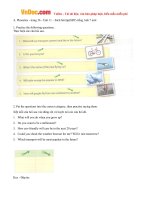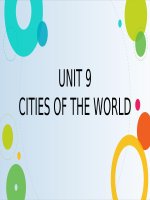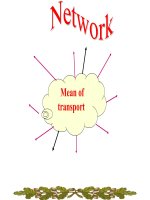Unit 11 Travelling in the Future Lesson 1 Getting started
Bạn đang xem bản rút gọn của tài liệu. Xem và tải ngay bản đầy đủ của tài liệu tại đây (97.91 KB, 4 trang )
<span class='text_page_counter'>(1)</span>Week: 33rd Planning date: 27/3/2014 Teaching date: 2/4/2014 Period: 87. Unit 11: TRAVELLING IN THE FUTURE Lesson 1: Getting started I. Objectives. By the end of the lesson, Ss can: - use lexical items ralated to future means of transport and movement. - understand the difference between facts and opinions - use will for future prediction II. Teaching aids: - Projector. III. Procedure 1. Class organization. - Greetings. - Checking attendance: 7A1……….. 7A2: ………….. 2. New lesson. Ss and T’s activities 1. Warm up. To start the lesson, ask Ss as a class to brainstorm on the board one or two means of transport that are now commonly used in Viet Nam. Connect this with what they have learnt in Unit 7 (Traffic) andUnit 10 (Energy) by asking Ss to describe how these means of transport work in which situations they are used, and the advantages and disadvantages of using them.. 2. Activities. Presentation - Elicit the new words. Contents Example: “motorbikes” - have motors powered by engines. - use petrol - used for road traiffic - advantages, practical, personal transport - disadvantages: not safe cause pollution Ask Ss how people in Viet Nam will travel around in year 2100. Ask them to predict it theirmeans of transport mentionedon the.
<span class='text_page_counter'>(2)</span> Write ‘flying car’ on the board. Ask Ss what they think how a ‘flying car’ might be different from an ordinary car (e.g.appearance, energy, advantages, disadvantages, etc.) Write ‘jet pack’ and ‘teleporter’ on the board. Ask Ss to guess what they are, them give explanations. ‘Jet pack’: a jet-powered device you wear on the back that will help you to fly (“động cơ phản lực mini”) ‘teleporter’: an imaginary method of transportation in which one disappears at one point, usually in an instant, and reappear at another - Check the new words: What and where - Let ss predict how people travel in the future, then write some of the students’ answers on the board. - Let ss draw the usage of “will” in this situation. Practice Have Ss cover the text and ask them to look at the piture only. Introduce the names of the students (Veronica, Mai, and Phuc). Ask them: - What can you see in the picture? - What are Veronica, Mai, and Phuc doing? What makes you think so? - What do you think is on the screen? Is there a connection between what is on the screen with what Mai is thinking about? - What topic are they talking about? Ask Ss to uncover the text. Play the. board will still be used. Ask them to explain their preductions. I. New words Flying car (n): ô tô bay Jet pack (n) : động cơ phản lực mini Teleporter (n): dịch chuyển tức thời Driverless car (n): ô tô không người lái Crash (v) (n): đâm, va chạm Avoid (v): tránh Helicopter (n) : máy bay trực thăng Imaginative(n) : giàu trí tưởng tượng. II. Model sentences: Eg: People will own driverless cars in the future. Will + V: for future prediction. III. Activities Activity 1 a. Answer the following questions..
<span class='text_page_counter'>(3)</span> recording and ask them to locate the parts of ‘flying cars’, ‘jet pack’, and ‘teleporter’. a. Ss work individually to answer the questions. Ss compare answers in pairs and then discuss as a class. T goes through each question and asks Ss how the text in the conversation supports their answers. (For question 2, however, T may draw Ss’ attention to the suffix-less. For question 4, T may remind Ss of the meaning of green in previous units). After the discussion, T writes correct answers on the board. Look out T emphasises-less is added to a noun to make an adjective. Ask Ss to give more examples. For a more able class, ask Ss to make sentences with the new adjectives created. b. Ss work in pairs to ask and answer the question. After that call some pairs to ask and answer for the class to listen. For a more advanced class, questions 2 & # can be used as a team-based class debate.. Key 1. a 4. a. 2. b. 3. c. b.. Key: 1. If there are too many flying cars, there will be traffic jams in the sky. Some means of transport will not be convenient in bad weather (e.g.jet pack). Future means of transport may use a lot of fuel 2. Draw Ss attention to the Remember box. which will make pollution worse. Give more examples if necessary and ask Ss to 2&3: Open answers from Ss. identify which are facts and which are Activity 2 opinions. Write a fact and an opinion Ask Ss to work in pairs to tick the Facts (which could be your personal vs. Opinions box. Then ask for their answers.
<span class='text_page_counter'>(4)</span> as a class. Ask Ss to explain their decisions before giving the keys. For question 5, tell Ss that a prediction is always an opinion. Ask Ss to expain before giving your own explanation.. opinion) about flying cars on board. Ask Ss to decide which statement could be proved and which is what you feel. 1. F 2. O 3. F 3. a. Ss work individually to come up with the 4. O 5. O means of transport mentioned in the Activity 3 a. conversation. Key: flying car b. T makes an example by giving a driverless car comvination, e.g. an electric car. Ask Ss to say how they think an electric car works. Then Ss work individually to make a list of the combined words. Production: 3C c. Tell Ss how to do this task by looking at the example given. Then ask Ss to work in pairs. After the discussion, ask the class how many comvined words they have. Elicit the words on the board. Then ask Ss to pick up one favourite combination from their list. Call on several pairs and have them to explain why they choose that means of transport as their favourite one. 3. Homework - Learn new words and phrases Prepare A closer look 1..
<span class='text_page_counter'>(5)</span>









